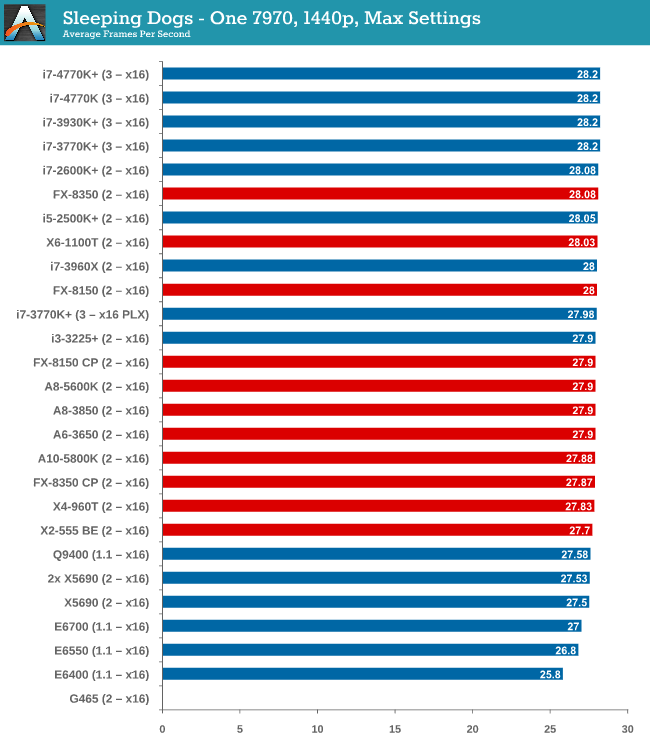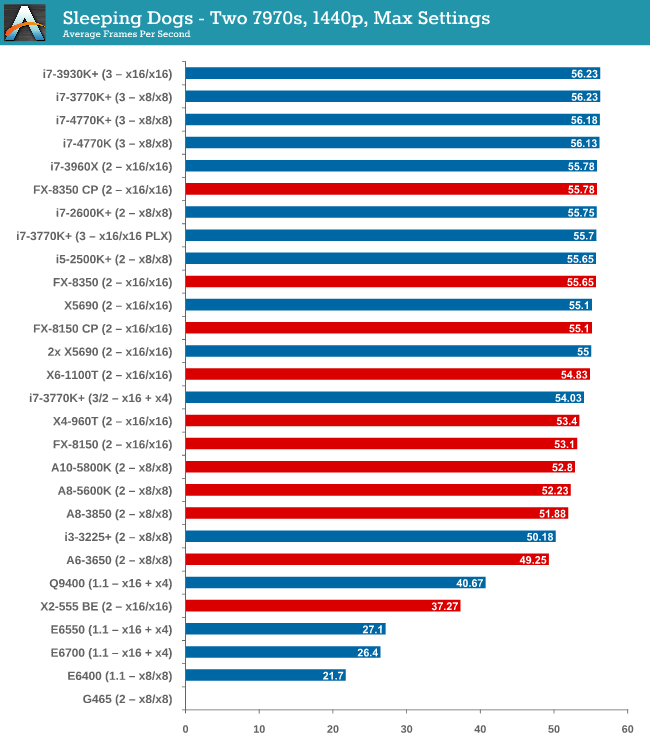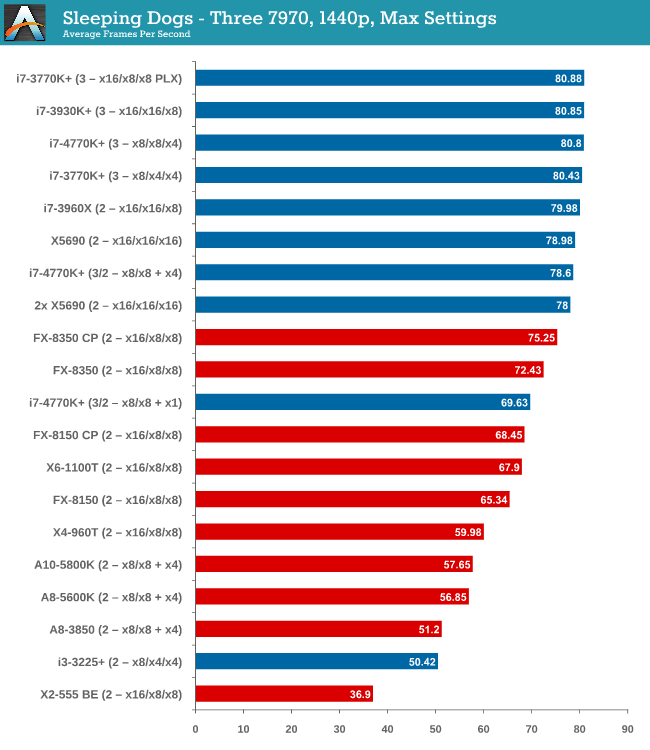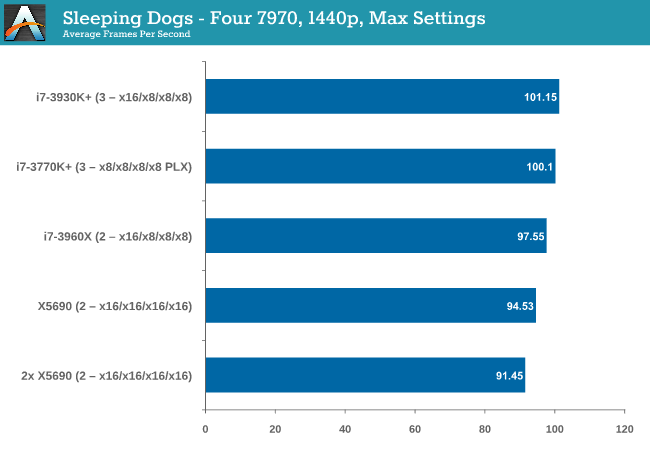Choosing a Gaming CPU at 1440p: Adding in Haswell
by Ian Cutress on June 4, 2013 10:00 AM ESTSleeping Dogs
While not necessarily a game on everybody’s lips, Sleeping Dogs is a strenuous game with a pretty hardcore benchmark that scales well with additional GPU power. The team over at Adrenaline.com.br are supreme for making an easy to use benchmark GUI, allowing a numpty like me to charge ahead with a set of four 1440p runs with maximum graphical settings.
One 7970

Sleeping Dogs seems to tax the CPU so little that the only CPU that falls behind by the smallest of margins is an E6400 (and the G465 which would not run the benchmark). Intel visually takes all the top spots, but AMD is all in the mix with less than 0.5 FPS splitting an X2-555 BE and an i7-3770K.
Two 7970s

A split starts to develop between Intel and AMD again, although you would be hard pressed to choose between the CPUs as everything above an i3-3225 scores 50-56 FPS. The X2-555 BE unfortunately drops off, suggesting that Sleeping Dogs is a fan of the cores and this little CPU is a lacking.
Three 7970s

At three GPUs the gap is there, with the best Intel processors over 10% ahead of the best AMD. Neither PCIe lane allocation or memory seems to be playing a part, just a case of threads then single thread performance.
Four 7970s

Despite our Beast machine having double the threads, an i7-3960X in PCIe 3.0 mode takes top spot.
It is worth noting the scaling in Sleeping Dogs. The i7-3960X moved from 28.2 -> 56.23 -> 80.85 -> 101.15 FPS, achieving +71% increase of a single card moving from 3 to 4. This speaks of a well written game more than anything.
One 580

There is almost nothing to separate every CPU when using a single GTX 580.
Two 580s

Same thing with two GTX 580s – even an X2-555 BE is within 1 FPS (3%) of an i7-3960X.
Sleeping Dogs Conclusion
Due to the successful scaling and GPU limited nature of Sleeping Dogs, almost any CPU you throw at it will get the same result. When you move into three GPUs or more territory, it seems that having the single thread CPU speed of an Intel processor gets a few more FPS at the end of the day.










116 Comments
View All Comments
gonks - Tuesday, June 4, 2013 - link
Great work Ian! Definitely waiting to see i5-3570K added into the mix, to see how it compares to the i5-2500k (and the 3570k beeing more futureproof thanks to PCIe 3.0).Harby - Tuesday, June 4, 2013 - link
Excellent review, though it would be awesome to see World of Warcraft and Rift in there. Both are heavily relying on CPU.yougotkicked - Tuesday, June 4, 2013 - link
As always, thanks for the great article and hard work Ian.I'd really like to see how a few of the tests scale with overclocked CPU's, notably those in which the sandy bridge processors were competitive with ivy bridge and haswell parts. Obviously overclocking introduces a lot of variables into your testing, but it would be very interesting to see a few of the popular choices tested (sandy bridge parts @ 4.5 are quite common, and many users on such a system were waiting for haswell before they upgrade).
eBombzor - Tuesday, June 4, 2013 - link
Crysis 3 benchmarks PLEASE!!frozentundra123456 - Tuesday, June 4, 2013 - link
Interesting results, but very limited as well. Why test at a resolution used by only 4% of the players?I would have rather seen the results at 1080p, over a wider variety of games. Especially RTS games and newer games like crysis 3, FC3, and Tomb Raider. I tested Heart of the Swarm on my computer with a HD7770 and i5 2320 and was able to max out the cpu in a 10 player skirmish match at ultra, 1080p. So I am sure an A8-5600 would be limiting in that case.
Even considering the results only of the games tested, the A8-5600k seems a strange choice. The i3 seems just as valid, considering it is equal or faster in every game but one, while using less power.
makerofthegames - Tuesday, June 4, 2013 - link
Question - are those blank entries for the Xeons because they could not run, or just that data was not collected for them?Awful - Tuesday, June 4, 2013 - link
Glad to see there's no reason to upgrade the i5-2500k in my desktop yet - still happily chugging away at 4.9GHz after 2 years!holistic - Tuesday, June 4, 2013 - link
Ian,Thank you, for your time, effort, and energy in compiling an encyclopedic database on the effects of cpu on single and multi gpu configurations, in alternate gaming/engine scenarios. Your work is insightful, informative, and wholly devoted to the science of benchmarking. This approach has helped me, as a relatively new computer enthusiast, to more deeply understand testing methodology in the computing field.
I am interested in the pure CPU benchmarks of Starcraft 2 with the 4770k and 4670k. I understand this game is not optimized, is directx9, and is extremely cpu limited with only 2 maximum cores active, and thus not in top priority for providing benchmarks. Will haswell be added to the benchmarking database for sc2?
Cheers,
Craig
khanov - Tuesday, June 4, 2013 - link
Ian, I have to say (again) that i7-3820 should be in this review.You say that i7-4770K is a better value proposition than Sandy Bridge-E (X79), I assume because you are only thinking of the expensive 6 core X79 CPU's. That changes if you do consider i7-3820.
X79 brings far better support for multi-gpu setups with enough PCIe lanes to feed multiple cards quite happily. No PLX needed. Pair that with an i7 3820 (cheaper than i7-3770K/i7-4770K) and you may find the performance surprisingly good for the price.
chizow - Friday, June 7, 2013 - link
I considered the 3820 numerous times (it's cheap at MC, same price as high-end 3770K/4770K) but I shy away because it inexplicably performs *WORST* than 2700K/3770K/4770K. I don't know why, it has more L3 cache, and is clocked higher before/after boost. Just an oddball chip.Besides, X79 as a platform was dated almost as soon as it released. PCIe 3.0 support is spotty with Nvidia (reg hack not guaranteed), no native USB 3.0 and no full SATA 6G support. I went for Z87 + 4770K instead because X79 + 3820 didn't offer any noticeable advantages while carrying a significant higher price tag (board price).